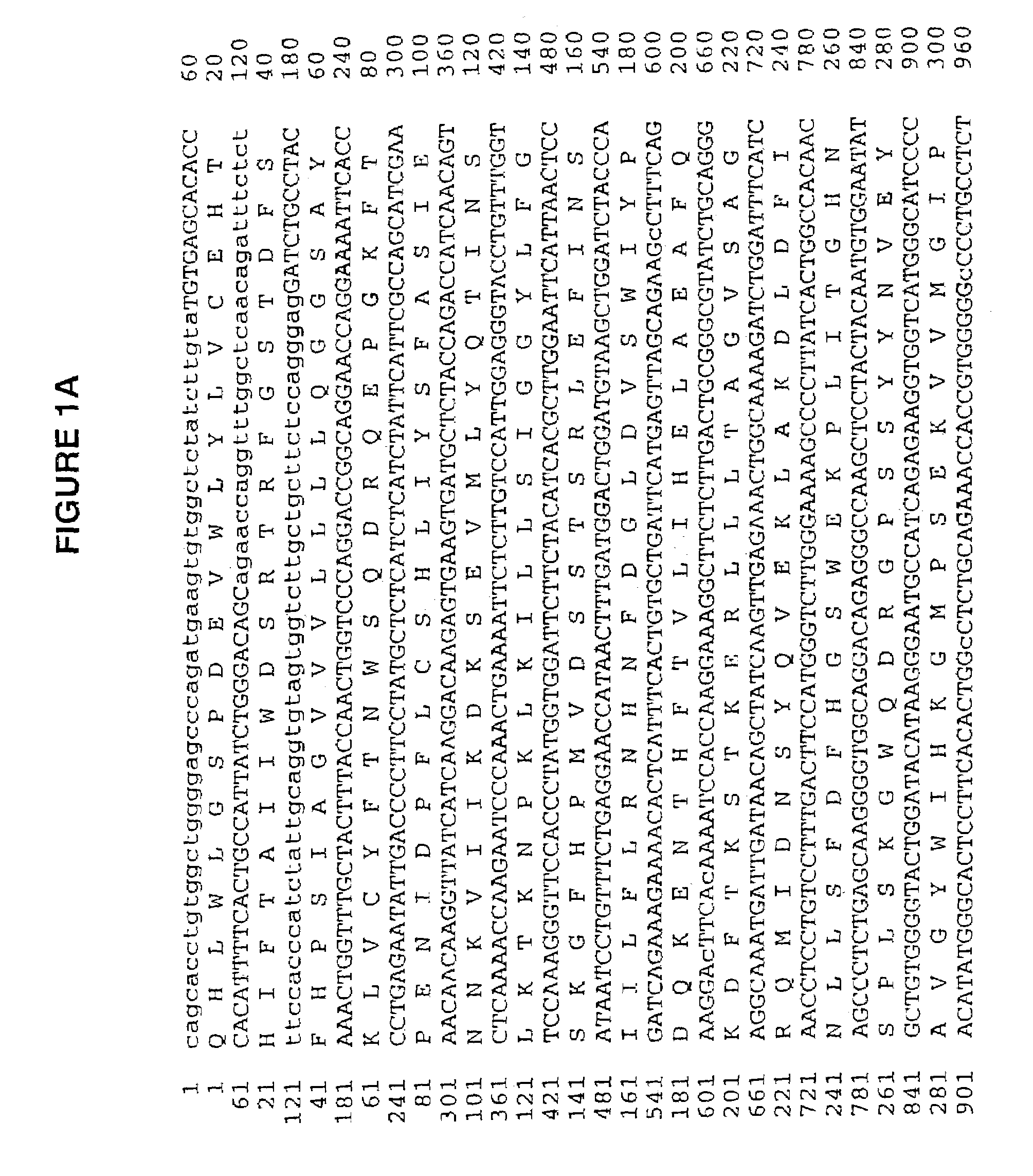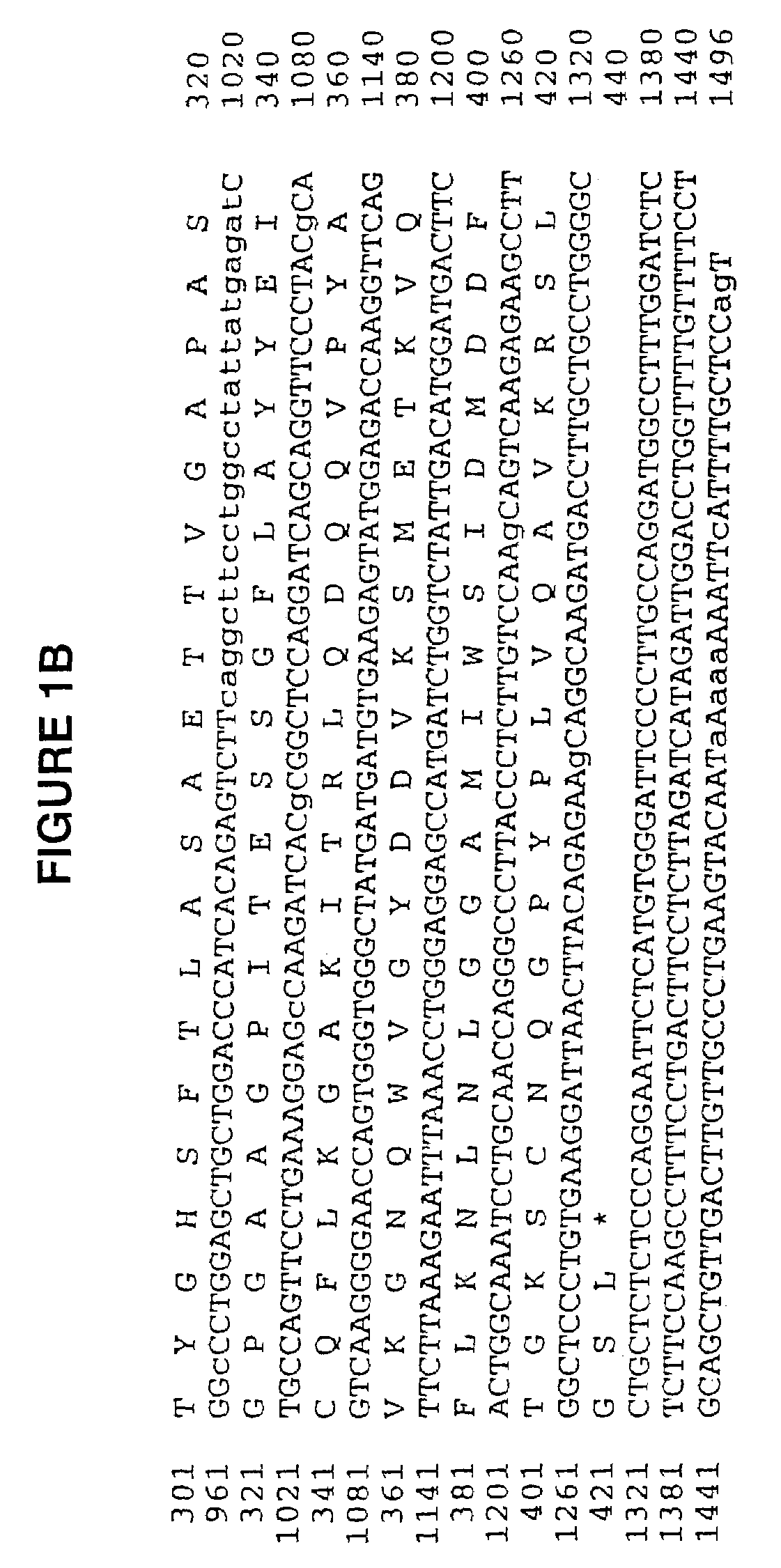Human cartilage glycoprotein
a cartilage glycoprotein and cartilage protein technology, applied in the field of human cartilage glycoprotein, can solve the problems of hepatosplenomegaly, bone lesions, neurological anomalies, accumulation of glucosylceramide (glucocerebroside) in the lysosome,
- Summary
- Abstract
- Description
- Claims
- Application Information
AI Technical Summary
Benefits of technology
Problems solved by technology
Method used
Image
Examples
example 1
Expression of HC gp-39 in vitro
[0070]Recombinant HC gp-39 was produced in vitro by transfecting an expression vector containing the cDNA into CHO cells and selecting stable cell lines.
[0071]The full length HC gp-39 gene was cloned into CDN in two pieces; a 660 bp Sac II-Bst EII fragment plus a 678 bp Bst EII-Bcl fragment, ligated together with the CDN vector cut with Sac II-Bcl I. This construct was transfected into CHO ACC 317 Cells by standard methods. Specifically, 20 mg of the HC gp-39 plasmid construct was linearized by restriction digestion and electroporated into 1.25×107 cell in 1 ml. Cells were seeded at a density of 2.5×103 cells per well and selected in minimal media in the absence of nucleosides. Secreted protein was recovered from the conditioned media and purified using Q sepharose flow through, S sepharose capture and sized on Suprose 12. The resulting material was greater than 95% pure as determined by Coomassie blue staining. HC gp-39L can also be expressed as descr...
example 2
Assay for Smooth Muscle Migration
[0072]Smooth muscle migration was measured in a chamber divided by a semi-permeable filter to which rHC gp-39 (2.3–766 mg / ml) was bound on one side. On the other side, human fetal smooth muscle cells were cultured. The extent to which cells migrated into the filter was monitored calorimetrically (optical density). rHC gp-39 elicited a stronger migration response in this assay than PDGF, a known stimulator of smooth muscle migration. This assay in this Example I can also be readily used for analysis of HC gp-39L.
example 3
Production of Polyclonal Antibodies Generated Against HC gp-39L
[0073]A partial HC gp-39L protein has been expressed in E. coli and used to generate polyclonal antiserum. A 1461 bp NdeI-Xhol cDNA fragment of HC gp-39L was cloned in frame as a fusion with an N-terminal His tag, in the Pet 16B vector system (Novagen). These constructs were transformed into E. coli through standard methods. The cells were propagated, lysed, and the protein purified by nickel affinity chromatography. The purified fusion protein was used to immunize rabbits for the production of polyclonal antiserum.
PUM
| Property | Measurement | Unit |
|---|---|---|
| apparent molecular weight | aaaaa | aaaaa |
| nucleic acid sequence | aaaaa | aaaaa |
| length | aaaaa | aaaaa |
Abstract
Description
Claims
Application Information
 Login to View More
Login to View More - R&D
- Intellectual Property
- Life Sciences
- Materials
- Tech Scout
- Unparalleled Data Quality
- Higher Quality Content
- 60% Fewer Hallucinations
Browse by: Latest US Patents, China's latest patents, Technical Efficacy Thesaurus, Application Domain, Technology Topic, Popular Technical Reports.
© 2025 PatSnap. All rights reserved.Legal|Privacy policy|Modern Slavery Act Transparency Statement|Sitemap|About US| Contact US: help@patsnap.com


